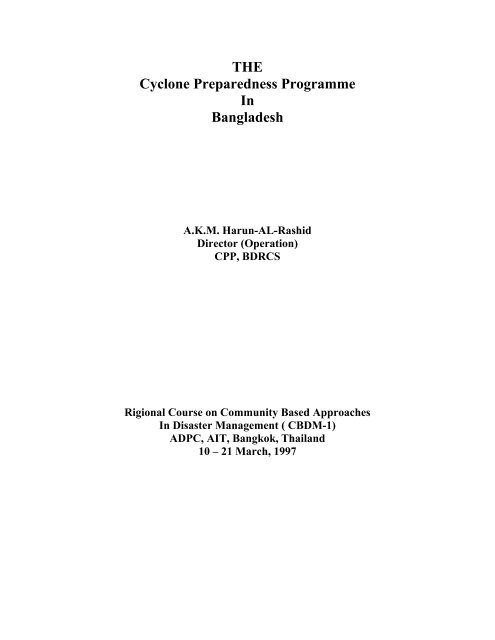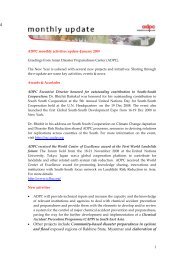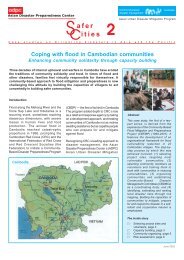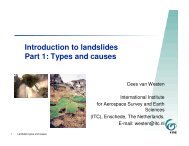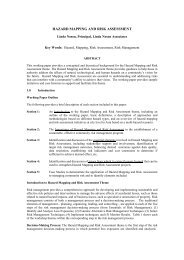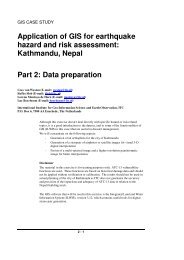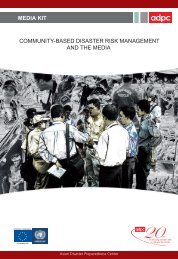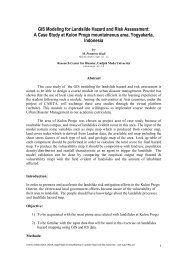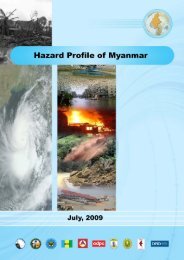The Cyclone Preparedness Programme in Bangladesh, Regional
The Cyclone Preparedness Programme in Bangladesh, Regional
The Cyclone Preparedness Programme in Bangladesh, Regional
Create successful ePaper yourself
Turn your PDF publications into a flip-book with our unique Google optimized e-Paper software.
THE<br />
<strong>Cyclone</strong> <strong>Preparedness</strong> <strong>Programme</strong><br />
In<br />
<strong>Bangladesh</strong><br />
A.K.M. Harun-AL-Rashid<br />
Director (Operation)<br />
CPP, BDRCS<br />
Rigional Course on Community Based Approaches<br />
In Disaster Management ( CBDM-1)<br />
ADPC, AIT, Bangkok, Thailand<br />
10 – 21 March, 1997
Index<br />
Sl. No. Subject Page<br />
1. Introduction 2<br />
2. <strong>Cyclone</strong> and Surge 2<br />
3. <strong>Cyclone</strong> <strong>Preparedness</strong> <strong>Programme</strong> 3<br />
4. Volunteers Organization and their Role 4<br />
5. Management 6<br />
6. Operational Method 7<br />
7. Stand<strong>in</strong>g order for <strong>Cyclone</strong> 8<br />
8. Tra<strong>in</strong><strong>in</strong>g of Volunteers and Public Awareness 13<br />
9. Telecommunication Network 14<br />
10 Warn<strong>in</strong>g Equipments and<br />
Gears for volunteers 15<br />
11. Transport 16<br />
Electronic Workshop and<br />
Speed Boat Workshop 16<br />
13. <strong>Cyclone</strong> Shelters 16<br />
14. F<strong>in</strong>ance and Resources 16<br />
15. Conclusion 17<br />
2
1. INTRODUCTION.<br />
<strong>Bangladesh</strong>, a small country, lies between 21 and 27 North of latitude and 88 and 92.5 East of<br />
Longitude. Situated on the tropic of Cancer, it bears a tropical nature with monsoon-type<br />
climate. Its small size, 55,598 square miles and large population, 120 millions, make it one of<br />
the most densely populated countries of the world It is located <strong>in</strong> the funnel, to the north, of the<br />
conically-shaped Bay of Bengal.<br />
<strong>The</strong> country, the most rever<strong>in</strong>e <strong>in</strong> the world with four major rivers and hundreds of tributaries<br />
from the Sub-Cont<strong>in</strong>ent flow<strong>in</strong>g <strong>in</strong>to the Bay of Bengal, is very flat but also very fertile, except<br />
for the Hill Tracts <strong>in</strong> the south east and rises just few feet above the sea level of the Bay of<br />
Bengal. It is very prone to natural disasters and has been repeatedly subjected to cyclones,<br />
floods, tornados, droughts, erosion, epidemics, etc.<br />
<strong>The</strong> country is particularly affected by cyclonic storms that come from the Bay of Bengal and<br />
which are normally accompanied by a tidal surge. <strong>The</strong> yearly cyclone-seasons, <strong>in</strong> April-May and<br />
October-November, are before and after the monsoon season. From 1797 to 1996, 62 major<br />
cyclonic storms and tidal surges have hit the <strong>Bangladesh</strong> coast.<br />
<strong>The</strong> low-ly<strong>in</strong>g coastal area and off-shore islands where some 11 millions people live has been<br />
particularly affected. It is estimated that some 8 millions people live on the 710 km. Long coast<br />
<strong>in</strong> the high risk area for cyclonic water surge.<br />
2. CYCLONE AND SURGE<br />
A <strong>Cyclone</strong> is a relatively small and <strong>in</strong>tense low-latitude warm-core low pressure area hav<strong>in</strong>g a<br />
counter clockwise w<strong>in</strong>d circulation <strong>in</strong> the Northern hemisphere and clockwise direction <strong>in</strong> the<br />
Southern hemisphere.<br />
Certa<strong>in</strong> environmental conditions have been found to be pre-requisites for the organization and<br />
development of cyclones. <strong>The</strong>y are :<br />
a) Warm Ocean temperature, A tropical <strong>Cyclone</strong> does not form if the sea temperature is less<br />
Than 27 celsius.<br />
b) Presence of low pressure region.<br />
c) Absence of strong vertical w<strong>in</strong>d shear.<br />
d) Presence of a certa<strong>in</strong> value of coriolis force appears at the latitude greater than 5 degrees<br />
Which gives the cyclone its rotational/sp<strong>in</strong>n<strong>in</strong>g motion.<br />
<strong>Cyclone</strong>s <strong>in</strong> the Bay of Bengal mostly orig<strong>in</strong>ate over the South Bay and the Andaman Sea. <strong>The</strong><br />
area of lowest pressure <strong>in</strong> a cyclone built-up is called the Eye of the cyclone. It is found well<br />
formed <strong>in</strong> the most severe cyclones.<br />
3
<strong>Cyclone</strong>s <strong>in</strong> the South Asian sub-cont<strong>in</strong>ent are classified accord<strong>in</strong>g to their <strong>in</strong>tensity and the<br />
follow<strong>in</strong>g nomenclatures are used :<br />
• Depression : W<strong>in</strong>ds upto 61 kms/hour<br />
• Cyclonic storm : W<strong>in</strong>ds from 62 to 87 kms/hour<br />
• Severe Cyclonic storm : W<strong>in</strong>ds from 88 to 117 kms/hour<br />
• Severe Cyclonic storm with<br />
Hurricane <strong>in</strong>tensity : W<strong>in</strong>ds above 117 kms/hour<br />
<strong>The</strong> <strong>Cyclone</strong>s are accompanied by heavy ra<strong>in</strong>s and swell of the sea called storm surges. Full or<br />
new moon effects on high tides re<strong>in</strong>force considerably the water surge that crosses the coast<br />
when the cyclone hits.<br />
Warn<strong>in</strong>g Signals<br />
11 stages of Storm warn<strong>in</strong>g Signals for maritime ports and 4 stages of signals for river ports<br />
be<strong>in</strong>g used <strong>in</strong> <strong>Bangladesh</strong>. <strong>The</strong>se signals are used for alert<strong>in</strong>g the coastal people.<br />
3. CYCLONE PREPAREDNESS PROGRAMME<br />
BACKGROUND<br />
From 1960 to 1965, 9 (n<strong>in</strong>e) cyclones hit the coastal belt of <strong>Bangladesh</strong>, kill<strong>in</strong>g over 50,000<br />
people, alone the cyclone of 11 May 1965 took some 20,000 lives.<br />
<strong>The</strong> idea of a <strong>Cyclone</strong> <strong>Preparedness</strong> activities started <strong>in</strong> 1965 when the National Red Cross<br />
Society now the <strong>Bangladesh</strong> Red Crescent Society (BDRCS) requested the International<br />
Federation (IFRC) formerly the League of Red Cross and Red Crescent Societies to support the<br />
establishment of a warn<strong>in</strong>g system for the population of the coastal belt. In 1966, the<br />
International Federation and the Swedish Red Cross began the implementation of a pilot scheme<br />
for <strong>Cyclone</strong> <strong>Preparedness</strong> which consisted of provid<strong>in</strong>g warn<strong>in</strong>g equipment such as, transistor<br />
radio, siren etc. and tra<strong>in</strong><strong>in</strong>g the local militia (Ansars), as the backbone of the warn<strong>in</strong>g and<br />
dissem<strong>in</strong>ation activities. <strong>The</strong> strategy was to use the exist<strong>in</strong>g structure at the village level <strong>in</strong>stead<br />
of creat<strong>in</strong>g a new and parallel structure. From 1966, the <strong>Cyclone</strong> Warn<strong>in</strong>g System was<br />
operational <strong>in</strong> 299 locations and supported by 473 team leaders.<br />
In May 1969, the first Weather Radar Station was <strong>in</strong>stalled <strong>in</strong> Cox’s Bazar by the Swedish “Save<br />
the Children Fund” <strong>in</strong> collaboration with the National Red Cross, the International Federation<br />
and the Swedish Red Cross Society.<br />
4
On 12 and 13 of November 1970, a major cyclone hit the coastal belt with w<strong>in</strong>d speed of 223<br />
Km/hour accompanied by a storm surge of 6 to 9 meters height, kill<strong>in</strong>g an estimated 500,000<br />
people and mak<strong>in</strong>g millions homeless and totally destitute.<br />
Follow<strong>in</strong>g the <strong>Cyclone</strong> of 1970, the United Nations General Assembly requested the<br />
International Federation to take a lead<strong>in</strong>g role <strong>in</strong> establish<strong>in</strong>g and improv<strong>in</strong>g the Pre-disaster<br />
plann<strong>in</strong>g programme of <strong>Bangladesh</strong>. <strong>The</strong> International Federation and the <strong>Bangladesh</strong> Red<br />
Crescent undertook an extensive evaluation of the programme and drew an new strategy, which<br />
as from February 1972 lead to the new programme consist<strong>in</strong>g of 20,310 volunteers <strong>in</strong> 204<br />
Unions of 24 Thanas and a transceiver telecommunication system (wireless transceiver radio <strong>in</strong><br />
22 stations).<br />
In June 1973, the Government of <strong>Bangladesh</strong> approved the new programme and accepted the<br />
f<strong>in</strong>ancial responsibility for the recurr<strong>in</strong>g expenses and set up a jo<strong>in</strong>t programme management by<br />
the creation of a <strong>Programme</strong> Policy Committee and a <strong>Programme</strong> Implementation Board.<br />
4. VOLUNTEERS ORGANISATION<br />
AND THEIR ROLE<br />
<strong>The</strong> <strong>Cyclone</strong> <strong>Preparedness</strong> <strong>Programme</strong>e (CPP) is organized <strong>in</strong> 258 Unions of 30 Thanas divided<br />
<strong>in</strong>to 2733 units. Each unit serves 1 or 2 village with an approximately population of 2 to 3<br />
thousand. 10 male and 2 female Volunteers are recruited from the respective Unit with popular<br />
support of the villagers.<br />
Accord<strong>in</strong>g to the By-law of the <strong>Programme</strong>, fulfillment of the follow<strong>in</strong>g criteria by a person will<br />
make him eligible to be a volunteer of the <strong>Programme</strong> :-<br />
1. Must be a permanent resident of the locality.<br />
2. Age should be <strong>in</strong> between 18 to 35 years.<br />
3. Must know how to read and write.<br />
4. Should be a strong, stout and healthy person.<br />
5. Must be a self supported person.<br />
6. Must have favourable attitude for voluntary work.<br />
7. Must be honest, s<strong>in</strong>cere and should have peoples support.<br />
8. Must have commitment to be a volunteer, should have time and<br />
Opportunity to render humanitarian services.<br />
5
In each Unit, the 10 male volunteers are divided <strong>in</strong>to 5 groups, 2 <strong>in</strong> each, to discharge the<br />
follow<strong>in</strong>g responsibilities :<br />
a. Dissem<strong>in</strong>ate cyclone warn<strong>in</strong>g signals issued by the <strong>Bangladesh</strong><br />
Meteorological Department to all people<br />
b. Assist people <strong>in</strong> tak<strong>in</strong>g shelter.<br />
c. Rescue distressed people affected by a cyclone.<br />
d. Provide First Aid to the people <strong>in</strong>jured by a cyclone.<br />
e. Assist <strong>in</strong> relief and rehabilitation operations.<br />
f. Assist <strong>in</strong> the implementation of the BDRCS Disaster <strong>Preparedness</strong> Plan.<br />
g. Assist <strong>in</strong> participatory community capacity build-up activities.<br />
h. Assist <strong>in</strong> the co-ord<strong>in</strong>ation of disaster management and development activities.<br />
Two female volunteers of the Unit provide first aid to the distressed women after the cyclone<br />
besides their task of rais<strong>in</strong>g awareness among the women folk <strong>in</strong> normal time.<br />
Unit Committee<br />
At Unit levels, 12 volunteers form a Unit Committee, elect one of them as Unit Leader and<br />
another as Deputy Unit Leader.<br />
Union Committee<br />
On an average 10 Units form a Union. <strong>The</strong> Unit Team leaders of a Union form a Union<br />
committee and elect one of them as the Union Team Leader and another as Deputy Union Team<br />
Leader.<br />
Thana (Sub-district) Committee<br />
On an average 10 Unions form a Thana(sub district). <strong>The</strong> Union Team Leaders of the Thana<br />
form the Thana Committee and elect one of them as Thana Team Leader and another as Deputy<br />
Thana Team Leader.<br />
6
5. MANAGEMENT<br />
Follow<strong>in</strong>g the withdrawal or International Federation as direct partner <strong>in</strong> the Implementation <strong>in</strong><br />
July 1973, an new <strong>Programme</strong> Management structure <strong>in</strong> a form of jo<strong>in</strong>t venture was created by<br />
the Government of <strong>Bangladesh</strong>(GOB) and the <strong>Bangladesh</strong> Red Crescent Society. An agreement<br />
was signed by both parties spell<strong>in</strong>g that the <strong>Programme</strong> will basically rema<strong>in</strong> Red Crescent <strong>in</strong><br />
nature and will be known as the <strong>Cyclone</strong> <strong>Preparedness</strong> <strong>Programme</strong>(CPP) of the <strong>Bangladesh</strong> Red<br />
Crescent Society with jo<strong>in</strong>t implementation and management scheme.<br />
Two Committees were created to jo<strong>in</strong>tly adm<strong>in</strong>ister and implement the programme. A 7 member<br />
policy Committee headed by the M<strong>in</strong>ister for Disaster Management and Relief is constituted to<br />
give policy directives and allocat<strong>in</strong>g resources for the programme. <strong>The</strong> Policy committee is<br />
constituted as follows :-<br />
1) M<strong>in</strong>ister for Disaster Management & Relief Chairman<br />
2) M<strong>in</strong>ister for Local Government, Rural Development & Co-operative Vice Chairman<br />
3) Chairman, <strong>Bangladesh</strong> Red Crescent Society Vice Chairman<br />
4) Member-1, M<strong>in</strong>istry of Plann<strong>in</strong>g Member<br />
5) Two Representative nom<strong>in</strong>ated by <strong>Bangladesh</strong> Red Crescent Society Member<br />
6) Secretary, M<strong>in</strong>istry of Disaster Management & Relief Member-Secretary<br />
A 15 Member Implementation Board, responsible for effective implementation and<br />
adm<strong>in</strong>istration of the programme is constituted as follows :-<br />
01) Secretary, M<strong>in</strong>istry of Disaster Management & Relief Chairman<br />
02) Secretary, Local Government Division, M<strong>in</strong>istry of<br />
Local Government, Rural Development and Co-operative Member<br />
03) Jo<strong>in</strong>t secretary(Relief), M<strong>in</strong>istry of Disaster Management & Relief Member<br />
04) Director General, Directorate of Relief and Rehabilitation Member<br />
05) Director General, Disaster Management Bureau Member<br />
06) Director General, <strong>Bangladesh</strong> Rural Development Board Member<br />
07) Chief Eng<strong>in</strong>eer, Public Health Eng<strong>in</strong>eer<strong>in</strong>g Directorate Member<br />
08) Deputy Secretary(Relief), M<strong>in</strong>istry of Disaster Management & Relief Member<br />
09) Representative of F<strong>in</strong>ance Division of the M<strong>in</strong>istry of F<strong>in</strong>ance Member<br />
10) Director, Meteorological Department Member<br />
11) Secretary General, <strong>Bangladesh</strong> Red Crescent Society Member<br />
12) Two representatives nom<strong>in</strong>ated by the Chairman, BDRCS Members<br />
13) Representative of M<strong>in</strong>istry of Information Member<br />
14) Representative of IFRC (If present) Member<br />
15) Director, <strong>Cyclone</strong> <strong>Preparedness</strong> <strong>Programme</strong> Member-Secretary<br />
<strong>The</strong> <strong>Programme</strong> has a total of 198 full time personnel and 27,330 tra<strong>in</strong>ed male volunteers and<br />
5466 female Volunteers.<br />
7
In Dhaka, the <strong>Programme</strong> office is staffed by 40 personnel headed by the <strong>Programme</strong> Director<br />
with the ma<strong>in</strong> function of manag<strong>in</strong>g the <strong>Programme</strong>.<br />
At the Field level, the implementation of the <strong>Programme</strong> is divided <strong>in</strong>to four levels(i.e., units,<br />
Unions, Thanas and Zones)<br />
At the Unit level, there are 2733 Teams of volunteers. Each Team has 10 male members and 2<br />
female members headed by a Team Leader. <strong>The</strong> Unit Teams are <strong>in</strong> the front l<strong>in</strong>e of the Warn<strong>in</strong>g<br />
System. <strong>The</strong>ir mandate is to dissem<strong>in</strong>ate the <strong>Cyclone</strong> warn<strong>in</strong>g signals among the villagers and to<br />
assist <strong>in</strong> their evacuation. <strong>The</strong> Teams are equipped with basic warn<strong>in</strong>g equipments such as hand<br />
Siren and Megaphones and one Transistor radio to receive meteorological <strong>in</strong>formation and<br />
cyclone warn<strong>in</strong>g signal bullet<strong>in</strong> transmitted by Radio <strong>Bangladesh</strong>. <strong>The</strong> Volunteers are selected<br />
by the villagers us<strong>in</strong>g a clearly def<strong>in</strong>ed set of criteria. <strong>The</strong> activities of the Volunteers are<br />
supported by 30 full time Assistant Directors based <strong>in</strong> 30 different Thanas. Each Thana has an<br />
office equipped with a Transceiver Radio. Between the cyclone seasons, the Assistant Directors<br />
conduct tra<strong>in</strong><strong>in</strong>g sessions for the Volunteers.<br />
<strong>The</strong> Thana office’s work is assisted and supervised by 6 (six) Zonal Deputy Directors. Each<br />
Zone has a permanent office situated <strong>in</strong> the district level.<br />
6. OPERATIONAL METHOD :<br />
<strong>The</strong> CPP Dhaka office, located <strong>in</strong> the BDRCS National HQ. Compound, receives, special<br />
weather bullet<strong>in</strong>s conta<strong>in</strong><strong>in</strong>g cyclone warn<strong>in</strong>g signals from the <strong>Bangladesh</strong> Meteorological<br />
Department as soon as a depression is formed <strong>in</strong> the bay of Bengal. <strong>The</strong> <strong>in</strong>formation is<br />
transmitted to the 6 Zonal Officers and the 30 Thana level Officers over HF Radio. <strong>The</strong> Asstt.<br />
Directors, <strong>in</strong> turn, pass it to Unions through VHF Radio. Where VHF Radio has not yet been<br />
<strong>in</strong>stalled the message is passed on by a messenger. <strong>The</strong> Union Team Leaders contact the Unit<br />
Team Leaders immediately. <strong>The</strong> unit Team Leaders with his Volunteers spread out <strong>in</strong> the<br />
villages and dissem<strong>in</strong>ate the <strong>Cyclone</strong> warn<strong>in</strong>gs, almost door to door, us<strong>in</strong>g megaphones, hand<br />
sirens and public address system. <strong>The</strong> Team Leaders at the same time keep track of the<br />
approach<strong>in</strong>g <strong>Cyclone</strong> by listen<strong>in</strong>g to national radio broadcasts over the transistor radio. <strong>The</strong><br />
Team Leaders are thus alerted and start work without loss<strong>in</strong>g of time. <strong>The</strong> Volunteers keep on<br />
announc<strong>in</strong>g the special weather bullet<strong>in</strong>s on patterns of the approach<strong>in</strong>g cyclone.<br />
When situation turns serious, the GOB passes order for evacuation. <strong>The</strong> Volunteers implement<br />
the order and advise and help people <strong>in</strong> tak<strong>in</strong>g shelter <strong>in</strong> cyclone shelters or other available safe<br />
places.<br />
When the cyclone is over, the volunteers rescue the <strong>in</strong>jured and marooned people, provide First<br />
Aid to the <strong>in</strong>jured, send the serious cases to the local hospitals, and assist <strong>in</strong> the post-cyclone<br />
emergency relief operation.<br />
8
7. STANDING ORDERS FOR CYCLONE<br />
In November 1985, the Government of <strong>Bangladesh</strong> <strong>in</strong>troduced Stand<strong>in</strong>g Orders for cyclone<br />
which specified the functions of each concerned Government M<strong>in</strong>istries, Divisions, Departments<br />
and Agencies <strong>in</strong>clud<strong>in</strong>g the specific functions of <strong>Cyclone</strong> <strong>Preparedness</strong> <strong>Programme</strong> of the<br />
<strong>Bangladesh</strong> Red Crescent Society. <strong>The</strong> Stand<strong>in</strong>g orders lay down the various actions to be taken<br />
at various stages by the <strong>Cyclone</strong> <strong>Preparedness</strong> <strong>Programme</strong>.<br />
<strong>The</strong> CPP plays a crucial role <strong>in</strong> the dissem<strong>in</strong>ation of cyclone warn<strong>in</strong>gs, evacuation, rescue, first<br />
aid and emergency relief works through its 32,796 volunteers <strong>in</strong> the coastal districts. Detailed<br />
duties of CPP are specified below :-<br />
CPP (Directorate)<br />
Normal Time<br />
a) Organize <strong>Preparedness</strong> <strong>Programme</strong> <strong>in</strong> cyclone prone areas on cont<strong>in</strong>u<strong>in</strong>g basis and hold<br />
Mobilization drill on disaster <strong>in</strong> April and September every year to check status of<br />
preparedness.<br />
b) Ensure that recruitment and tra<strong>in</strong><strong>in</strong>g of volunteers are complete before April every year.<br />
a) Ensure that unit, union and thana committees are organized and ready accord<strong>in</strong>gly.<br />
a) Ensure that unit, Union and thana offices are also organized and meet<strong>in</strong>gs at unit, union<br />
and thana levels are held regularly.<br />
c) Ensure :<br />
a) Availability of authorized equipment with the volunteers and trouble free function<strong>in</strong>g<br />
thereof.<br />
I. Proper function<strong>in</strong>g of wireless communication between CPP HQ and CPP officers at<br />
Thana level and between CPP thana office and CPP Union offices.<br />
d) Assist local level disaster management committees to chalk out thana and union<br />
cont<strong>in</strong>gency plans <strong>in</strong>clud<strong>in</strong>g earmarked shelters, killas, high rise safe places and ensure<br />
that evacuation plans are known to the people <strong>in</strong> general.<br />
e) Ensure that members of thana and Union Disaster Management Committee, Ansars,<br />
V.D.Rs. and Social workers are tra<strong>in</strong>ed/oriented on cyclone warn<strong>in</strong>g system.<br />
9
f) Create awareness amongst the people about cyclone warn<strong>in</strong>g signals and popularize<br />
preparedness measures through meet<strong>in</strong>g, discussions, posters, leaflets and film shows,<br />
drills, and demonstration dramas etc. <strong>in</strong> co-ord<strong>in</strong>ation with Disaster Management Bureau<br />
(DMB).<br />
g) Ma<strong>in</strong>ta<strong>in</strong> FAX for ensur<strong>in</strong>g communication to Storm Warn<strong>in</strong>g Centre at all times.<br />
Alert Phase<br />
a) Establish Control Room at CPP HQ and CPP Zonal offices and co-operate with District,<br />
Thana and Union authorities <strong>in</strong> establish<strong>in</strong>g control rooms at those levels.<br />
b) Ma<strong>in</strong>ta<strong>in</strong> close contact with Department of Meteorology.<br />
c) Receive Special Weather Bullet<strong>in</strong>s from Met. Office and pass the same to Thana, Zonal<br />
offices and advise Thana offices to pass the same to Union offices on post-haste basis.<br />
d) Advise Thana Asstt. Directors, CPP, to contact Union Tam Leaders through wireless or<br />
send liaison Volunteers to the Union Team leaders with <strong>in</strong>struction for the CPP<br />
Volunteers to listen to Radio broadcasts. Union Team Leaders and their Co-workers to<br />
commence activity as per <strong>in</strong>structions laid down <strong>in</strong> the volunteer’s Guide Book<br />
(Ghurnijhor Nirdeshika) published by CPP.<br />
e) Alert Chairmen and Members of the Implementation Board of CPP.<br />
f) Alert DCs, TNOs and Union Parishad Chirman, Ward Members and local NGOs.<br />
Warn<strong>in</strong>g Phase<br />
a) Propose emergency meet<strong>in</strong>g of the Implementation Board.<br />
b) Check deployment and function<strong>in</strong>g of CPP volunteers <strong>in</strong> the field.<br />
c) Advise people to shift livestock, poultry and other domestic animals to high rise places<br />
and killas under adequate safety measures.<br />
d) Instruct Development Officer(s) of the CPP to advise Thana Nirbahi Officer, Chairman<br />
Thana Disaster Management Committee to immediately convene Committee meet<strong>in</strong>g.<br />
e) Instruct Development officers to advise Union Management Committee to convene<br />
meet<strong>in</strong>g.<br />
f) Implement decisions of the emergency meet<strong>in</strong>g of the Implementation Board.<br />
10
g) Instruct Development officer to ensure that decisions of Thana Disaster Management<br />
Committees and Union Disaster Management Co-ord<strong>in</strong>ation Committees are<br />
implemented.<br />
h) Transmit Special Weather Bullet<strong>in</strong>s to all Zonal, Thana and union field offices.<br />
i) Ensure that people have been warned by the development officers and the volunteers.<br />
j) Keep the Chairman, Implementation Board, Director General Disaster Management<br />
Bureau and Directorate of Relief and BDRCS <strong>in</strong>formed of the situation <strong>in</strong> the field from<br />
time to time.<br />
Disaster Phase<br />
a) Co-ord<strong>in</strong>ate activities with all other agencies and N.G.Os.<br />
b) Instruct Development Officers to collect prelim<strong>in</strong>ary damage reports from the respective<br />
union team leaders.<br />
c) Prepare prelim<strong>in</strong>ary damage report by collect<strong>in</strong>g <strong>in</strong>formation from the Development<br />
Officers for the Chairman of the Implementation Board.<br />
d) Ensure that Development Officers and volunteers carry-out rescue operations and provide<br />
First Aid as needed.<br />
e) Advise Development Officers to <strong>in</strong>struct union team leaders to keep wireless<br />
communication open and make frequent contact with development officer and transmit<br />
damage report as collected.<br />
Recovery Phase<br />
a) Direct field offices to :<br />
• Extend assistance to <strong>in</strong>oculation and vacc<strong>in</strong>ation drive and other health measure.<br />
• Participate <strong>in</strong> reahbilitation efforts.<br />
• Co-ord<strong>in</strong>ate activities with local NGOs.<br />
11
CPP at Field Level<br />
<strong>The</strong> field officers of the CPP at the level of district zonal officer and the development officer and<br />
union leaders and volunteers will discharge the follow<strong>in</strong>g functions, besides other functions<br />
with<strong>in</strong> their respective jurisdiction.<br />
Normal Time<br />
a) Organize simulated preparedness programme <strong>in</strong> cyclone prone areas on cont<strong>in</strong>u<strong>in</strong>g basis<br />
and hold mobilization drill on disaster <strong>in</strong> April and September every year to check status<br />
of preparedness.<br />
b) Complete before April recruitment and tra<strong>in</strong><strong>in</strong>g of volunteers as per CPP procedure and<br />
organize group<strong>in</strong>g of families through them for facilitat<strong>in</strong>g evacuation <strong>in</strong> time of need.<br />
c) Check up stock of authorized equipment with volunteers and undertake repair and acquire<br />
if necessary needed equipments.<br />
d) Check and keep <strong>in</strong> proper function<strong>in</strong>g of wireless communication and cont<strong>in</strong>ue wireless<br />
communication with CPP Headquarters and CPP officers at thana and union level.<br />
e) Educate and create awareness amongst the local people about cyclone preparedness<br />
programme and understand<strong>in</strong>g of warn<strong>in</strong>g signals of various types. Motivate and<br />
popularize preparedness measures through meet<strong>in</strong>gs, discussions, posters, leaflets and<br />
film shows.<br />
f) Earmark and keep shelter, killas, high rise safe places fit and ready and publicize and<br />
make known to the people evacuation plans towards these.<br />
g) Co-ord<strong>in</strong>ate with the thana and the union parishad to motivate the public and the<br />
volunteers about the cyclone danger responses.<br />
Alert Phase<br />
a) Set up Control room and ma<strong>in</strong>ta<strong>in</strong> contact with the Thana, the Unions and the CPP.<br />
b) Keep close contact with the local office of the department of Meteorology and other<br />
offices and use means of communication for <strong>in</strong>put of cyclone alertness.<br />
c) Receive Special Weather Bullet<strong>in</strong>s from the CPP and pass the same to the local officers.<br />
d) Alert local Chairman and Members of District/ Thana/ Union Disaster Management<br />
Committees and local NGOs, religious leaders and teachers.<br />
12
e) Instruct sub-ord<strong>in</strong>ate offices and officers to send liaison volunteers to the union Team<br />
Leaders with <strong>in</strong>struction for CPP volunteers to listen to Radio Broadcast. Do ensure that<br />
union Team leaders and their co-workers commence activity as per <strong>in</strong>structions laid down<br />
<strong>in</strong> the volunteer guide book (Ghurnijhar Nirdeshika) published by CPP.<br />
Warn<strong>in</strong>g Phase<br />
a) Inform DC/TNO/Union Parishad Chairman to hold emergency meet<strong>in</strong>g of the Disaster<br />
Management Committees.<br />
b) Implement decisions of emergency meet<strong>in</strong>gs of the committees.<br />
c) Detail and check development and function<strong>in</strong>g of CPP Volunteers to ensure that<br />
livestock, poultry and other domestic animals are shifted to raised land, killas etc. under<br />
adequate safety measures.<br />
d) Transmit Special weather Bullet<strong>in</strong>s to all field offices <strong>in</strong>clud<strong>in</strong>g District, Thana, Union<br />
and Zones.<br />
e) Warn the people about the threat.<br />
f) Advise and help people <strong>in</strong> tak<strong>in</strong>g shelters when evacuation order is given.<br />
g) Use Megaphone, Signal Light and signal flag to give f<strong>in</strong>al warn<strong>in</strong>g to the people.<br />
h) Keep all <strong>in</strong>clud<strong>in</strong>g Thana, District, D.G. Relief and Rehabilitation <strong>in</strong>formed of the<br />
situation <strong>in</strong> the field from time to time<br />
i) Co-ord<strong>in</strong>ate activities with all other agencies, NGO’s.<br />
Disaster Phase<br />
a) Prepare a report on the impact of the cyclone by collect<strong>in</strong>g <strong>in</strong>formation and submit it to<br />
CPP Headquarter, union disaster management committee, and the thana and district<br />
control rooms.<br />
b) Carry out rescue operation and provide First-Aid as needed <strong>in</strong> co-ord<strong>in</strong>ation with the<br />
union and thana authorities.<br />
c) Assist local adm<strong>in</strong>istration <strong>in</strong> distribution of relief goods.<br />
13
Recovery Phase<br />
a) Keep wireless communication open and make frequent contact with CPP and transmit<br />
damage reports as soon as received.<br />
b) Help local bodies/local adm<strong>in</strong>istration <strong>in</strong> disposal of dead bodies and carcasses.<br />
c) Assist <strong>in</strong> <strong>in</strong>oculation vacc<strong>in</strong>ation drive and other Health measures.<br />
d) Participate <strong>in</strong> rehabilitaion efforts along with other Agencies <strong>in</strong>clud<strong>in</strong>g NGOs.<br />
<strong>The</strong> Warn<strong>in</strong>g Orders identify at each stages the relation between the <strong>Bangladesh</strong> Red Crescent<br />
society, <strong>Cyclone</strong> <strong>Preparedness</strong> <strong>Programme</strong> and the various concerned Government M<strong>in</strong>istries.<br />
Department and Agencies.<br />
8. TRAINING OF VOLUNTEERS<br />
AND PUBLIC AWARENESS<br />
I. To ma<strong>in</strong>ta<strong>in</strong> a high level of efficiency, the Volunteers are given tra<strong>in</strong><strong>in</strong>g on Red Cross and<br />
Red Crescent movement, <strong>Cyclone</strong> and its behaviour, warn<strong>in</strong>g Signals and their dissem<strong>in</strong>ation,<br />
evacuation and shelter<strong>in</strong>g rescue, First Aid and relief operation. On recruitment, the Volunteers<br />
are given prelim<strong>in</strong>ary tra<strong>in</strong><strong>in</strong>g at local level by the CPP officers.<br />
A 3 days basic tra<strong>in</strong><strong>in</strong>g is then given to the Volunteers, batch by batch, on the subjects mentioned<br />
above.<br />
<strong>The</strong> Unit and Union Team Leaders are given 5 days tra<strong>in</strong><strong>in</strong>g on the above subjects as well as<br />
leadership tra<strong>in</strong><strong>in</strong>g at Thana or district level.<br />
<strong>The</strong> officers and Thana Team Leaders who are also tra<strong>in</strong>ers of Volunteers are also given disaster<br />
management and leadership tra<strong>in</strong><strong>in</strong>g. <strong>The</strong> First Aid Volunteers given First Aid tra<strong>in</strong><strong>in</strong>g by First<br />
Aid <strong>in</strong>structors of BDRCS. <strong>The</strong> tra<strong>in</strong><strong>in</strong>g programme is designed to broaden their technical<br />
knowledge about disasters <strong>in</strong> general and <strong>Cyclone</strong> <strong>in</strong> particular, to enhance their familiarity with<br />
all aspects of <strong>Cyclone</strong> <strong>Preparedness</strong> <strong>Programme</strong>, to familiarize them with the pr<strong>in</strong>ciples of<br />
management and their application <strong>in</strong> <strong>Cyclone</strong> <strong>Preparedness</strong> <strong>Programme</strong> for more effective<br />
management of disasters, to promote their leadership ability, to create better understand<strong>in</strong>g of<br />
their roles and responsibilities and the need for co-ord<strong>in</strong>at<strong>in</strong>g efforts with people of other<br />
agencies as well as committees and to enhance the first aid dispensation capability.<br />
II. Public awareness is an <strong>in</strong>tegral and very important part of <strong>Cyclone</strong> <strong>Preparedness</strong> activities<br />
for its successful implementation. Keep<strong>in</strong>g this <strong>in</strong> view, the CPP implements the follow<strong>in</strong>g<br />
public awareness activities <strong>in</strong> the <strong>Cyclone</strong> prone coastal areas :<br />
14
a) Public awareness through Volunteers. <strong>The</strong> local Volunteers through their social<br />
contacts motivate the village people as a cont<strong>in</strong>uous process. This is a part of the Volunteers<br />
tra<strong>in</strong><strong>in</strong>g.<br />
b) <strong>Cyclone</strong> Drills and Demonstration. <strong>Cyclone</strong> drill and demonstrations are frequently<br />
held by the Volunteers, also participated by the local people. <strong>The</strong>se drills and demonstrations are<br />
attended by large members of village people.<br />
c) Stag<strong>in</strong>g of Drama. To make the village people realize the importance of preparedness,<br />
a special drama depict<strong>in</strong>g the significance of preparedness is written by an expert writer and it is<br />
staged <strong>in</strong> the coastal areas. More than 200 thousand people have witnessed this drama so far.<br />
d) Film Shows. Documentary films on disasters and preparedness are shown <strong>in</strong> the villages<br />
<strong>in</strong> co-operation with <strong>Bangladesh</strong> Meteorological department and Films and Publication<br />
Department.<br />
e) Posters and Leaflets. Posters and Leaflets on preparedness are regularly distributed to<br />
the coastal <strong>in</strong>habitants. A special directive on evacuation, <strong>in</strong>terpretation of warn<strong>in</strong>g signals,<br />
<strong>in</strong>structions for the fishermen etc. <strong>in</strong> the form of poster and leaflets has been published and<br />
distributed to the community.<br />
f) Publicity Campaign. Immediately before the cyclone season, a publicity campaign is<br />
organized with the Government officials, N.G.O’s and the local public to familiarize and to<br />
create awareness on <strong>Cyclone</strong> preparedness.<br />
g) Radio and Television. Before cyclone seasons, arrangements are made to telecast<br />
documentary films on disaster and preparedness and special features on disasters and<br />
preparedness are broadcast over Radio <strong>Bangladesh</strong>. Dur<strong>in</strong>g disaster period, the T.V. and Radio<br />
play an important role by announc<strong>in</strong>g the meteorological signals, evacuation order, <strong>in</strong>structions<br />
to the public as often as is required.<br />
9. TELECOMMUNICATION NETWORK<br />
<strong>The</strong> <strong>Cyclone</strong> <strong>Preparedness</strong> <strong>Programme</strong> operates an extensive network of Radio Communications<br />
facilities, <strong>in</strong> the coastal areas, l<strong>in</strong>ked to its communications centre at its head office at Dhaka.<br />
<strong>The</strong> purpose of this network is exclusively for the disaster management tasks. <strong>The</strong> network<br />
consists of a comb<strong>in</strong>ation of HF/SSB and VHF/FM Radios, which covers most of the high risk<br />
cyclone areas.<br />
<strong>The</strong> Telecommunication network of the <strong>Cyclone</strong> <strong>Preparedness</strong> programme is composed of three<br />
(3) elements as follows :<br />
15
a) High Frequency (HF) Transceiver radios, with a ma<strong>in</strong> base station located at the Dhaka<br />
Headquarter, with the function to transmit <strong>in</strong>formation related to the cyclone and the<br />
preparedness. From the field stations the local <strong>in</strong>formation related to the progress and effects of<br />
the cyclone is sent to Dhaka HQ.<br />
b) A Field station system of very high frequency (VHF) transceivers with the function to<br />
receive and transmit messages from HF Field Stations to Sub-Stations located at Union level.<br />
c) Transistor Radios used by each unit Team leader (2733 teams) with the function of<br />
receiv<strong>in</strong>g meteorological <strong>in</strong>formation and cyclone warn<strong>in</strong>g signal bullet<strong>in</strong>s transmitted by Radio<br />
<strong>Bangladesh</strong> Special Weather Bullet<strong>in</strong> on regular basis dur<strong>in</strong>g the time of cyclone or depression.<br />
<strong>The</strong> HF Transceivers (Field Stations) of the CPP have been <strong>in</strong> operations from 1972 and the<br />
VHF (field Sub station) s<strong>in</strong>ce 1990. S<strong>in</strong>ce the end of 1995, the telecommunication network<br />
covers almost 80 % of the estimated needs of the coastal belt. Dur<strong>in</strong>g after the cyclone of April<br />
1991, the HF and VHF transceivers were the only means of communication from the coastal belt<br />
of <strong>Bangladesh</strong> and proved their effectiveness before, dur<strong>in</strong>g and after the cyclone. <strong>The</strong> network<br />
has been as important asset for the post-cyclone relief operation to enable rapid collection of<br />
essential <strong>in</strong>formation from the affected areas and to transmit operational directives to the relief<br />
teams as it may proved aga<strong>in</strong> dur<strong>in</strong>g 1994 and 1995 cyclone.<br />
CPP is now operat<strong>in</strong>g a total of 115 Radio stations, out of which, 60 stations are located <strong>in</strong><br />
cyclone shelters, built by the BDRCS, <strong>in</strong> the high risk cyclone prone areas. Almost all these<br />
radio stations are powered by solar panels with storage batteries. <strong>The</strong>re are now 25 stations were<br />
both HF/SSB and VHF/FM Radio transceivers are operat<strong>in</strong>g, and there are 8 stations where only<br />
HF/SSB Radio transceivers are operat<strong>in</strong>g. Only VHF/FM Radio Transceivers are operated <strong>in</strong> 82<br />
stations.<br />
10. WARNING EQUIPMENTS AND<br />
GEARS FOR VOLUNTEERS<br />
I. Warn<strong>in</strong>g equipments :<br />
To receive the meteorological storm warn<strong>in</strong>g signals, the Unit Team leaders are provided<br />
with a transistor radio.<br />
To dissem<strong>in</strong>ate the warn<strong>in</strong>g signals among the villagers megaphones, sirens, public<br />
address equipments, signal lights and signal flags are provided to each volunteers team.<br />
II. Volunteers gears :<br />
To facilitate the volunteers movement <strong>in</strong> the cyclonic adverse weather, they are provided<br />
with ra<strong>in</strong> coats, gum boots, hard hats, life jackets and torch lights.<br />
Beside these, the first aid & rescue volunteers are provided with first aid and rescue kits.<br />
16
11. TRANSPORT<br />
For successful implementation of the cyclone preparedness activities, the 2733 Unit Team<br />
Leaders have been provided with a bicycle each. <strong>The</strong> Thana Team Leaders and Officers of the<br />
<strong>Programme</strong> <strong>in</strong> the field level have been provided with a motorcycle each. Speed boats are also<br />
provided some thana offices. Zonal offices have been provided with a pick up jeep each<br />
12. ELECTRONIC WORKSHOP AND<br />
SPEED BOAT WORKSHOP<br />
For repair and ma<strong>in</strong>tenance of telecommunication equipment, warn<strong>in</strong>g equipment, speed boats,<br />
speed boat eng<strong>in</strong>es, 3 workshop have been established <strong>in</strong> Dhaka, Chittagong and Barisal.<br />
13. CYCLONE SHELTERS<br />
After the devastat<strong>in</strong>g cyclone of 1970, Government and other agencies undertook construction of<br />
multi-purpose cyclone shelters. Dur<strong>in</strong>g 1972-9 under 1 D.A. credit 238 shelters were<br />
constructed <strong>in</strong> coastal districts out of which 11 appear to have been washed away. <strong>The</strong>se shelters<br />
are normally used as primary and high schools. <strong>The</strong>se are 3 storied structures. Each center is<br />
capable of accommodat<strong>in</strong>g about 2000 people dur<strong>in</strong>g cyclone and tidal surge.<br />
After 1985 cyclone, <strong>Bangladesh</strong> Red Crescent Society constructed 62 shelters, Caritas and other<br />
NGO’s constructed 20 shelters. <strong>The</strong>se shelters are 2-storied frame build<strong>in</strong>g with free ground<br />
floor 3 meter height on R.C.C columns, which can accommodate 800 people dur<strong>in</strong>g cyclone and<br />
tidal surge.<br />
After devastat<strong>in</strong>g cyclone of 1991, various organizations like <strong>Bangladesh</strong> Red Crescent Society,<br />
M<strong>in</strong>istry of Education under Saudi grant, E.E.C, local Government Eng<strong>in</strong>eer<strong>in</strong>g Bureau as well<br />
as several NGO’s have constructed considerable number of cyclone shelters which are of<br />
different types and design. At present about 1200 cyclone shelters are available for use by the<br />
coastal people.<br />
14. FINANCE AND RESOURCES<br />
To run the <strong>Programme</strong>, there is an arrangement between the Government of <strong>Bangladesh</strong> (GOB)<br />
and the <strong>Bangladesh</strong> Fed Crescent Society (BDRCS). <strong>The</strong> GOB provides some of the runn<strong>in</strong>g<br />
adm<strong>in</strong>istrative cost of the <strong>Programme</strong> annually. <strong>The</strong> present year’s grant is Tk. 8.2 million<br />
equivalent to US$-195200. <strong>The</strong> BDRCS provides capital assets, operational costs, and a part of<br />
the recurr<strong>in</strong>g costs through IFRC assistance which <strong>in</strong>cludes telecommunication, warn<strong>in</strong>g<br />
equipment such and as transistor radio, megaphones, sirens, PA System etc. and also transport<br />
like pickup, motor cycle and speed boat and cost relat<strong>in</strong>g to volunteers tra<strong>in</strong><strong>in</strong>g.<br />
17
After the devastat<strong>in</strong>g cyclone of April 1991, IFRC has provided f<strong>in</strong>ancial and material support to<br />
CPP through a 5-years “Plan of Action”. Which was orig<strong>in</strong>ally planned to be completed by<br />
1996. A proposal to extented it by one year is aspected to be approved.<br />
15. CONCLUSION<br />
S<strong>in</strong>ce the <strong>in</strong>ception of <strong>Cyclone</strong> <strong>Preparedness</strong> <strong>Programme</strong> <strong>in</strong> 1972, a total of 158 depressions have<br />
formed <strong>in</strong> the Bay of Bengal out of which 16 <strong>in</strong>tensified <strong>in</strong>to severe cyclonic storm. <strong>The</strong><br />
<strong>Programme</strong> faced all the situations with determ<strong>in</strong>ation and courage and gradually achieved<br />
greater success <strong>in</strong> mov<strong>in</strong>g people to shelters and sav<strong>in</strong>g life and property of coastal people.<br />
From the above facts, it can be summarized that the coastal people have accepted the <strong>Cyclone</strong><br />
<strong>Preparedness</strong> <strong>Programme</strong> and reduction of loss of life and property are the results of<br />
implementation of the <strong>Cyclone</strong> <strong>Preparedness</strong> <strong>Programme</strong>.<br />
18


